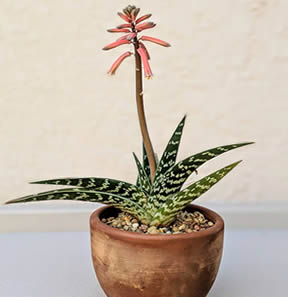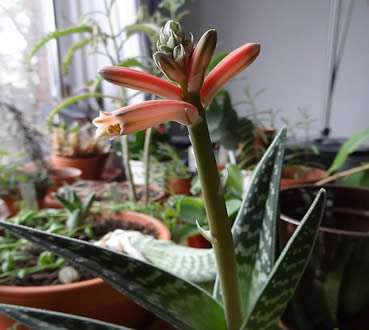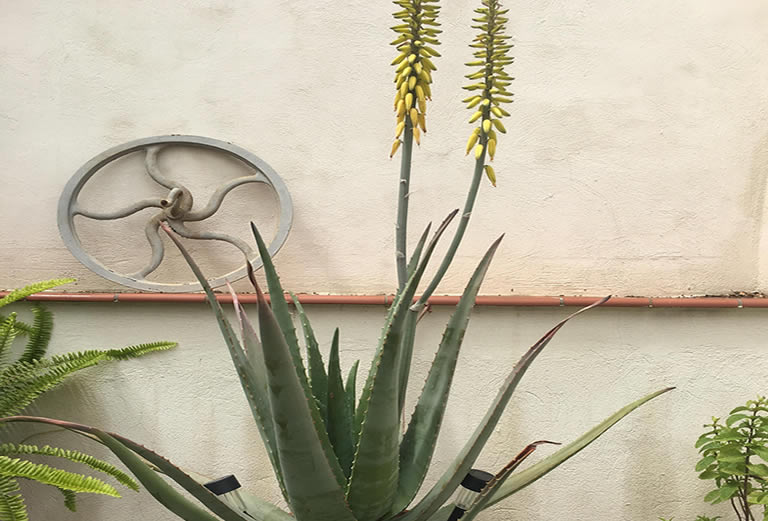In this article I cover everything you need to know about the flowering that accompanies an aloe bloom. From, why and how an aloe plant blooms to, reasons for a non-blooming aloe plant and how to get your aloe to bloom when it refuses to produce flowers.
Table of Contents
The Ultimate Guide to Aloe Blooms & Aloe Vera Flowers
Let’s begin by taking a quick look at exactly what an aloe plant is and the type of flowers it produces.
How an aloe plant and its blooms differ from other flowering succulents
The aloe plant is a tropical perennial succulent that is native to parts of Africa, Madagascar, Jordan, the Arabian Peninsula and various islands in the Indian Ocean such as Mauritius, Réunion and Comoros.
Aloe plants, including the very popular aloe vera, all bloom and produce flowers.
These flowering succulents are very hardy plants that can survive in the driest of desert environments.
The most common type of aloe plant, especially to houseplant lovers, is the aloe vera. However, there are actually over 550 flowering succulents that belong to this genus of plant (not 400 as many websites will tell you).
Aloe vera is not just commonly grown as a houseplant but its byproducts are also used in many household products. Likewise it is also used in pharmaceutical processes even though there is almost no clinical evidence for the effectiveness of aloe vera.
Aloe vera, like all aloe plants, does produce beautiful colorful blooms though.
Aloe vera produces yellow blooms while other aloe plants offer different variations of colors from red and orange to yellow as well as a mixture of those colors.
However, many aloe houseplant owners are unaware of this as most aloe houseplants do not bloom because the environmental conditions prevent flowering.
I will show you how to overcome the environmental problems that prevent aloe houseplants from blooming so you can enjoy yearly aloe flowers in your home.
Aloe plants are hardy succulents and require very little care and this makes it a popular houseplant and also a popular garden plant when cultivated in the correct climate zones (see our USDA climate zone guide).
The unique and strange aloe plant flowers
Aloe plant flowers are beautiful and come in a range of colors.
The most common colors for aloe flowers are yellow, orange and red.
Aloe vera is the most well known of the aloe plant and has become very popular across America as a houseplant.
It has yellow blooms which do look lovely but I personally prefer the mixture of colors you get from other aloe species.
Many aloe plants have flowers that display more than one color.

You can see the striking colors in the aloe flowers on the African Aloe (Aloe Africana) in the image above.
This to me offers just a little more visual appeal than the standard all-yellow blooms of the aloe vera.
The Aloe Castanea is another favorite of mine due to its deep red cat’s tail blooms.
Now let’s get to the nitty-gritty of aloe blooms and the flowers that these plants produce.
Below I cover the fundamentals of aloe flowers. This information applies to all aloe species including aloe vera.
Why aloe plants flower
With a large variety of different species of aloe plants, that grow in different areas including very dry desert type environments, you may wonder why an aloe plant produces blooms at all.
Aloe plants bloom due to their age and the amount of sunlight they get.
In the wild aloe flowers provide nectar for many birds, insects and mammals in areas that are essentially deserts with scant resources.
From an an evolutionary point of view aloe plants have evolved to produce flowers even in the driest and harshest of desert conditions.
They have done this because of the benefits they offer wildlife in those harsh areas.
As birds, and new evidence suggests bees also, feed on the nectar in the flowers they naturally carry seeds to other areas to help with pollination.
So you could say that aloe plants flower as a survival mechanism and as a means of perpetuating the species.
When aloe plants usually produce flowers
So when do aloe plants bloom and when can you expect to see flowers on your plant?
Aloe bloom times are dependent on the species and climate zone.
Aloe plants in USDA climate zones 7 – 9 bloom in May to March.
In zones 9 – 10 blooms usually appear in March to April while in zones 10 – 12 you can expect a summer bloom.
Indoor aloe plants will likely bloom in winter or spring.
Keep in mind that aloe plants only flower once the plant has matured. Plants younger than 4 years of age will not bloom.

To determine exactly when your aloe houseplant will bloom you will need to know the specific aloe species you own.
Having said that, the information in the above sections of this article should be helpful to determine the time of year when you can likely expect to see some flowers.
Aloe plant flowering cycles & how to use them
Now that you know when aloe plants bloom you will want to know how often they bloom.
Aloe plants are perennials that flower every year.
Most aloe plants bloom at least once per year though some will bloom more than once.
Aloe houseplants often do not bloom at all unless steps are taken to force the plant to bloom.
With 500 species of aloe plants I cannot possibly list all of them here and outline how many times they bloom per year.
However, as a general rule-of-thumb you can expect your aloe plant to bloom at the very least once every year. Just don’t be surprised if your plant blooms again before the 12 months have passed.
This is especially true of an aloe garden plant that is growing in the correct tropical or subtropical climate zone.
How long an aloe plant stays in bloom
So how long does an aloe bloom last?
Aloe blooms can last several months.
Aloe is a hardy plant that can withstand varying light conditions and the driest of desert environments. So it should come as no surprise the blooms of this plant are hardy and long-lasting also.
Using the same simple steps that you would use to force a mature aloe plant to bloom, you can help keep your plant’s blooms last for longer.
I cover these steps below but if you want a quick tip for maintaining long-lasting blooms then the best thing you can do for increasing the lifespan of aloe blooms is to ensure the plant gets enough direct sunlight.
You will also want to make sure the aloe plant is growing in an environment that has a comfortable temperature close to its native habitat s this will also help lengthen the lifespan of the blooms.
How long you can expect aloe flowers to last on average
An aloe bloom may last several months but what about the individual flowers?
Aloe flowers can last weeks on the plant.
Aloe blooms last several months with old flowers being replaced by new ones as they die.
Cut aloe flowers will last only a few days though sometimes new flowers will bloom on the stem as old flowers die.
Aloe flowers are often seen in floral arrangements but they do not last long. Aloe blooms in arrangements tend to shed foliage and flowers fast.
Aloe flowers, unlike other succulents such as amaryllis, tend to die quickly when they are removed from the parent plant.
Whenever possible leave the flowers on the plant for a longer flower life.
What to do when your aloe plant blooms
So what action steps do you need to take when your aloe plant blooms?
When an aloe plant blooms you should maintain a good care routine by watering the plant when the top layer of soil dries out.
You must also ensure the plant gets plenty of light.
Fertilize the aloe very sparingly once only during bloom time, using about half strength normal houseplant or succulent fertilizer.
When aloe blooms die prune the plant to make way for new flowers.
Aloe plants are hardy succulents that thrive in even the driest of desert conditions so you really don’t need to do much to your plant when it starts flowering.
Unlike other succulents, such as a blooming amaryllis which requires a little extra care during the blooming stage, your aloe plant will be just fine with its normal care routine.
See our ultimate guide to aloe plant care.
This means watering the aloe only when the top layer of soil dries out which will be, on average, about every 3 weeks. And only fertilizing the plant once, and very sparingly, during its blooming phase.
Do not give into the temptation of fertilizing your aloe when you tend to your other houseplants. A
loe needs fertilized only once per year.
You can use a normal houseplant fertilizer but you must prepare it at half the strength of what is the manufacturer recommends.
Personally I prefer to use a high quality succulent fertilizer for aloe plants though I still only make it up at half strength.
It is always easier to add more fertilizer if a plant needs it than it is to deal with the effects of over-fertilization.
Having said that, you are unlikely to need to add any additional fertilizer to an aloe plant.

Aloe plants have evolved to thrive in very sparse, hot and dry conditions. They do not need, and will react poorly to (what would be to other plants) normal fertilization levels.
So whatever fertilizer you are using, be sure to only make it up to half the strength of what is recommended. Always follow this advice unless you are using a dedicated, specific aloe fertilizer (and then you can just follow the instructions to the letter).
Guide for when your aloe plant refuses to bloom
So what do you need to do if your beloved aloe plant simply refuses to flower?
Let’s take a look at what can cause a lack of blooms in aloe plants and what you can do to try to force an aloe to bloom.
Why your aloe plant will not flower
Although aloe are easy-care plants it can be frustrating when you take really good care of your plant but it refuses to flower.
I often get asked, “why is my aloe plant not flowering”? Here are the most likely causes.
The most common cause for your aloe plant not blooming is its age. Only mature aloe plants bloom.
A plant younger than 4 years old will not bloom.
The second most common reason for a non-blooming aloe plant is a lack of sunlight.
There can be a few other reasons for a non-blooming aloe plant but by far the most likely causes are down to the plants immature age and a lack of sunlight.
The majority of aloe houseplants do not bloom simply due to insufficient light.
Although aloe plants are fairly tolerant of different light conditions in order to bloom they need plenty of sunlight.
If you have a plant that is older than 4 years of age and refuses to bloom then follow the steps outlined below to make your plant bloom.
How to make an aloe bloom
Below are some simple tips and tricks to help force a stubbornly non-blooming aloe plant to produce flowers.
Be aware that the steps I outline will only work when used on a mature aloe plant.
If your plant is immature and younger than 4 years old, it will simply not bloom no matter what you do.
Instructions to make aloe plants (including aloe vera) start flowering
If you are growing an aloe plant indoors it will take more care and attention to get the plant to bloom than it would for an outdoor aloe.
This is because aloe is a tropical succulent that blooms in very dry desert conditions.
Most homes have an adequate local climate for a large group of succulents (such as amaryllis and haworthia) but they are not really ideal for aloe.
Although your aloe plant will grow and be fairly content under normal household conditions it may never bloom unless you take direct action.
Below are some steps you can take to force a mature aloe plant to bloom.
- Ensure your aloe plant is placed somewhere that gets plenty of good direct sunlight.
- Aloe needs a minimum of 8 hours of sunlight per day. More is better.
- If need be move your aloe plant throughout the day to ensure it is getting the maximum amount of sun possible.
- Alternatively consider using an inexpensive grow light as this will almost guarantee a bloom.
- Ensure the temperature around the plant is between 60°F and 80°F. Try not to let the temperature drop below 55°F. A grow light can also help keep temperatures high during the day.
- Keep humidity levels around the plant to a minimum. Aloe like dry air.
- Add a little liquid fertilizer to the plant, made up to half strength only! Do this only once per year at the most.
By far the most successful action you will take to force an aloe plant to bloom is to make sure it gets enough sunlight.
Apart from owning an immature plant (only plants older than 4 years can bloom), lack of sunlight is the biggest cause for a lack of flowers.
For this reason I advise many aloe plant owners to keep a small grow light above their plants to ensure blooms.
Small household grow lights, like theses ones, start as low as about 20 bucks and are designed to sit above the plant are are barely noticeable.
Using a grow light during the day with your aloe plant is by far the easiest and most effective way of guaranteeing a bloom.

